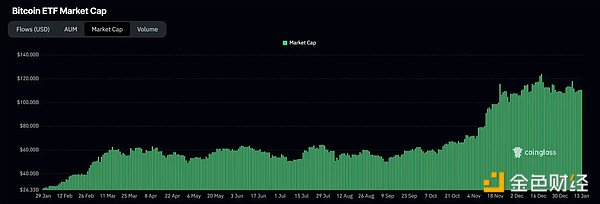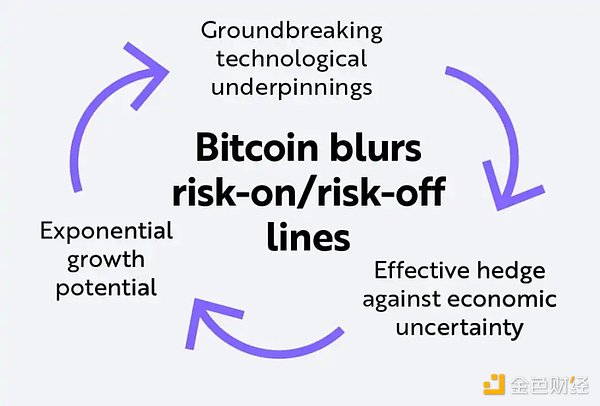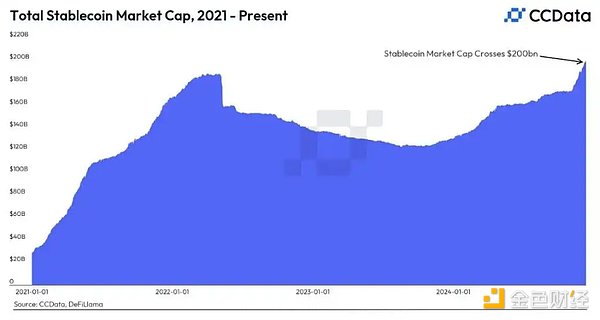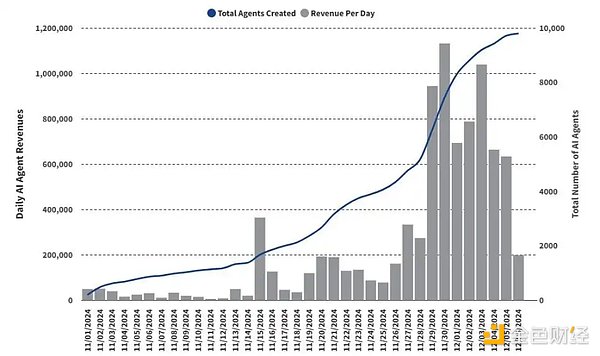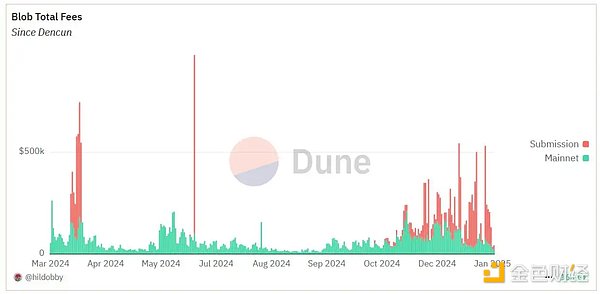As we enter 2025, the market sentiment is highly optimistic, supported by actual progress and groundbreaking innovations. This article summarizes the core narratives of the annual crypto sector, incorporating personal insights and research findings from leading industry institutions, including Bitwise, VanEck, Ark Invest, and a16z.
Let's explore the trends shaping the future of digital assets.
1. Bitcoin Gains Economic Traction
In 2024, the market dynamics of Bitcoin underwent significant changes, laying the foundation for the key narratives of 2025.
In January 2024, the launch of a Bitcoin spot exchange-traded fund (ETF) marked a milestone in the integration of cryptocurrencies with traditional finance. Among them, the iShares Bitcoin Trust (IBIT) managed by BlackRock stood out, attracting nearly $38 billion in net inflows in its first year, making it the most successful ETF debut in history.
Notably, the inflows into IBIT even surpassed the famous Invesco QQQ Trust (QQQ), which tracks the Nasdaq 100 index. By mid-2024, IBIT had received around $19.7 billion in net inflows, slightly ahead of QQQ's $19 billion.
BTC ETF Inflows | Source: Coinglass
1) Historic ETF Inflows and Growth Potential
Historical data shows that ETFs typically attract moderate inflows initially, but as investors become more familiar and trusting of these instruments, the inflows can grow significantly. Given this pattern, the strong early performance of the Bitcoin ETF in 2024 suggests that 2025 may see even wider adoption and greater capital inflows.
2) Macroeconomic Tailwind: Interest Rate Cuts
The macroeconomic environment at the end of 2024 provided favorable conditions for Bitcoin and other risk assets. In the fourth quarter, the Federal Reserve cut interest rates four times, reducing the total by 1%. This monetary easing policy aimed at controlling inflation is expected to continue into 2025.
The interest rate cuts lowered the opportunity cost of holding non-yielding investments, thereby enhancing the appeal of risk assets like Bitcoin and providing strong support for their growth.
3) Institutional Adoption: Corporate and Governmental Interest
In 2024, the Bitcoin market shifted from being primarily driven by retail speculation to large-scale institutional investment.
Corporate Interest: Under the leadership of Michael Saylor, MicroStrategy significantly expanded its Bitcoin holdings, purchasing around 258,320 BTC worth approximately $22.07 billion over the year, with a return on investment of 74.3%. This aggressive accumulation strategy solidified MicroStrategy's position as a leading corporate Bitcoin holder and demonstrated the potential for high returns on such investments, which may influence other companies' decisions to make similar allocations in 2025.
Governmental Interest: At the government level, the incoming administration of President Donald Trump conveyed a supportive stance towards cryptocurrencies and explored the possibility of establishing a strategic Bitcoin reserve through an executive order. Although the details and feasibility of this reserve plan are still under discussion, the mere consideration of Bitcoin as a strategic asset by the U.S. government may prompt other countries to explore the inclusion of Bitcoin in their national reserves, further enhancing the legitimacy and stability of the cryptocurrency market.
Trump Promises to Establish a Bitcoin Strategic Reserve at the Nashville Bitcoin Conference | Source: Financial Times
4) Conclusion
The successful launch of a Bitcoin ETF, favorable macroeconomic policies, and the increasing institutional interest signal that Bitcoin is undergoing a transformative period. As 2025 unfolds, these narratives will drive Bitcoin's transition from a speculative asset to a mainstream financial instrument, attracting a more diversified investor base and solidifying its position in the global financial ecosystem.
2. Bitcoin: A Unique Hedge Asset?
In traditional finance, "hedge" assets are those that investors tend to choose during periods of economic uncertainty or market volatility. Government bonds and gold are representatives of this category, favored for their relative stability and the backing of sovereign entities.
Government Bonds: Debt securities issued by national governments, promising periodic interest payments and the return of principal at maturity. Their low default risk and predictable returns make them attractive during market downturns.
Gold: As a store of value, gold is revered for its scarcity and intrinsic worth, often maintaining or appreciating in value during financial crises.
In recent years, particularly through the analysis of ARK Invest, Bitcoin has been gradually evolving into a hedge asset, exhibiting the potential to provide shelter for investors during turbulent times. Here are the key observations:
Inherent Hedging Characteristics
Bitcoin offers financial sovereignty, reduces counterparty risk, and enhances transparency. Its decentralized nature ensures that it is not controlled by a single entity, mitigating the risks associated with centralized financial systems.
Advantages over Traditional Assets
Bitcoin's decentralization, limited supply, high liquidity, and convenience far surpass those of bonds, gold, and cash. These attributes make Bitcoin a versatile asset capable of seamless global transactions in the digital age.
1) Outperformance Compared to Traditional Assets
Over the past seven years, Bitcoin has achieved an annualized return of 60%, far exceeding the average 7% return of bonds and other major assets. Within a five-year holding period, Bitcoin investors have consistently profited, while bonds, gold, and short-term U.S. Treasuries have lost 99% of their purchasing power over the past decade.
Adaptability to Interest Rate Changes
Bitcoin's price appreciation has persisted across various interest rate environments, demonstrating its resilience and potential to hedge against monetary policy fluctuations.
Performance During Hedge Periods
During recent financial crises (such as the regional bank failures), Bitcoin prices have surged by over 40%, showcasing its potential as a hedge asset.
Low Correlation with Other Asset Classes
Between 2018 and 2023, Bitcoin's correlation with bonds was only 0.26, while the correlation between bonds and gold was 0.46. This low correlation indicates that Bitcoin can effectively diversify investment portfolios.
Disruptive Potential in the Hedge Asset Market
Bitcoin's current valuation of around $1.3 trillion is only a small fraction of the $130 trillion fixed-income market, suggesting significant growth potential if Bitcoin is widely accepted as a hedge asset.
Bitcoin's unique positioning and strong performance as a hedge asset are redefining the global financial landscape, providing investors with an unprecedented diversification option.
The Perception of Bitcoin as a Hedge Asset is Improving | Source: Ark Invest
2) The Shift in Bitcoin's Perception from "Risk Asset" to "Hedge Asset"
Although Bitcoin's past high volatility has led many to classify it as a "risk asset," as it matures and the aforementioned characteristics become more prominent, perceptions are changing. As the global economic environment evolves, Bitcoin's role in investment portfolios may further expand, potentially redefining traditional asset allocation strategies.
3. Crypto Stocks to Watch in 2025
In 2024, crypto companies caused a stir on Wall Street, becoming one of the highest-performing sectors of the year. Many companies are planning to go public in 2025, and some may even surpass traditional financial (TradFi) institutions in market capitalization.
1) Crypto Companies Likely to Go Public in 2025
Analysts predict that 2025 will be the "Year of Crypto IPOs," with the following companies expected to make their initial public offerings:
Kraken: A cryptocurrency trading platform that is expected to go public in 2025.
Anchorage Digital: A digital asset platform that is about to enter the public market.
Chainalysis: A blockchain data platform that is expected to go public.
Figure: A fintech company that plans to IPO.
2) Coinbase's market value may exceed Charles Schwab
As Coinbase's assets under management grow rapidly, many believe it may surpass Charles Schwab to become the world's largest broker by 2025. This potential shift is attributed to Coinbase's diversified revenue streams, including its Ethereum Layer 2 network Base, staking services, and stablecoin business.
3) Impacts of these developments
Increased industry legitimacy: The entry of prominent crypto companies into the public market will enhance the legitimacy of the cryptocurrency industry, attracting previously hesitant investors.
Broader investor access: Public listings will allow more investors to gain exposure to the crypto industry through traditional investment vehicles, without the need to directly purchase cryptocurrencies.
Changing market dynamics: The inclusion of crypto companies like MicroStrategy and Block in major indices such as the S&P 500 may attract funds from index funds, ETFs, and investors, further integrating cryptocurrencies into the mainstream financial system.
Evolving competitive landscape: As crypto companies grow in market capitalization and influence, traditional financial institutions may face increased competition, driving innovation and adaptability in the financial industry.
These changes signify the maturation of the cryptocurrency industry, marking its transition from a niche market to a crucial component of the global financial ecosystem.
4. Stablecoin market may double by 2025
In 2024, the stablecoin market experienced significant growth, with its market capitalization surpassing the $200 billion mark. This expansion is expected to accelerate in 2025, with the market potentially doubling in size.
1) Growth in 2024 and projections for 2025
In 2024, the stablecoin market capitalization skyrocketed to $200 billion, reflecting increased adoption and integration with various financial systems.
Growth drivers: The growing demand for digital assets that provide the stability of traditional fiat currencies while enabling seamless transactions and serving as a hedge against cryptocurrency volatility.
With the rise in adoption, the stablecoin market's prospects remain promising, and 2025 may be a turning point for its growth.
Stablecoin market capitalization reached $200 billion in 2024 | Image source: CoinDesk
Industry analysts predict that by the end of 2025, the stablecoin market size may double. This forecast is based on the following factors:
Increased widespread acceptance of digital payments
Rapid advancements in blockchain technology
Clearer regulatory frameworks
These factors collectively create a more favorable environment for the proliferation and utilization of stablecoins.
2) Stablecoins and the US dollar hegemony
Contrary to early concerns that stablecoins could undermine the dominance of the US dollar, the latest analysis by Reuters suggests that stablecoins may actually strengthen the US dollar's leading position.
US dollar-pegged stablecoins can support cross-border transactions denominated in US dollars, enhancing the utility of the US dollar within the global financial system.
This development highlights the adaptability of the US dollar in the evolving digital economy.
3) Impacts of stablecoin growth
Enhancing financial inclusion: Stablecoins provide financial service access to regions with limited banking infrastructure, promoting broader economic participation.
Improving transaction efficiency: The use of stablecoins simplifies cross-border payments, significantly reducing costs and settlement times compared to traditional banking systems.
Regulatory considerations: As the stablecoin market expands rapidly, regulators are accelerating the development of frameworks to ensure financial stability and prevent illicit activities.
Integration with traditional finance: The increasing acceptance of stablecoins by financial institutions indicates that the fusion of traditional finance and digital assets is accelerating, potentially leading to more innovative financial products and services.
5. RWA: A key crypto narrative for 2025
The tokenization of real-world assets (RWA) is rapidly evolving, digitizing traditional assets such as secured lending, US Treasuries, commodities, and equities, enhancing the liquidity, transparency, and accessibility of financial markets.
1) Growth prospects for 2025
According to Bitwise data, the tokenization of the RWA market has grown from less than $2 billion three years ago to around $13.7 billion. With increased adoption and technological advancements, Bitwise projects this market to grow to $50 billion by 2025.
Venture capital firm ParaFi estimates that the RWA market could reach $2 trillion by 2030, while the Global Financial Markets Association (GFMA) estimates its potential market value could be as high as $16 trillion by 2030.
2) Drivers of growth
Superior asset management
Tokenization provides instant settlement, lower costs than traditional securitization, and continuous liquidity. It enhances transparency and offers more convenient access to a variety of asset classes.
Institutional adoption
Large financial institutions are increasingly embracing RWA tokenization. For example, BlackRock has partnered with Securitize to tokenize a $515 million institutional digital liquidity fund on Ethereum, the largest US Treasury tokenization fund to date.
Technological advancements
Developments in blockchain technology and smart contracts have facilitated the efficient and secure tokenization of assets, attracting more investors and issuers.
3) Impacts on the financial ecosystem
Enhanced liquidity
Tokenization allows assets to be fractionally held, enabling investors to buy and sell partial assets, thereby improving market liquidity.
Expanded investment access
Investors can gain exposure to previously illiquid or hard-to-access diversified asset classes, achieving investment democratization.
Improved operational efficiency
Automated processes through smart contracts have reduced the administrative burden and costs associated with asset management and transactions.
Regulatory considerations
As the market grows, the regulatory framework is evolving to address issues of security, compliance, and investor protection.
4) Conclusion
The tokenization of real-world assets (RWA) is reshaping the financial landscape, bringing higher efficiency, accessibility, and liquidity. This area is expected to see significant growth by 2025 and beyond, with tokenized RWA becoming a cornerstone of modern finance, attracting both institutional and retail investors seeking innovative investment opportunities.
6. AI agents to see exponential growth
In 2024, AI agents emerged as a hot crypto narrative, driven by platforms like Virtuals and a16z, which have developed no-code solutions to make the deployment of AI agents more accessible. These specialized AI bots aim to understand user intent and execute complex tasks, streamlining processes across various applications.
1) Expansion of AI agents in 2025
In 2025, the integration of AI agents within the crypto ecosystem is expected to expand significantly, extending beyond decentralized finance (DeFi) into multiple domains:
Social media: AI agents (such as AIXBT) are transforming platforms like Crypto Twitter by providing real-time market intelligence and trend analysis, enhancing the efficiency of information dissemination.
Financial analysis: AI-powered analytical tools provide investors with deep insights, helping them make more informed decisions in the volatile crypto markets.
Entertainment and interactive applications: AI agents are being used to create engaging content and interactive experiences, enriching user participation within the crypto community.
With the increasing availability and cost-effectiveness of AI agent development, their number is expected to see a surge. Currently, there are over 10,000 AI agents with millions of daily active users. By the end of 2025, the number of AI agents is projected to grow to 1 million, indicating their widespread application across various platforms.
Exponential Growth of AI Agents by 2024 | Image Source: VanEck
The fusion of AI technology and meme culture has given rise to AI-themed meme coins, adding a new dimension to the cryptocurrency market. The success of projects like Terminal of Truths and $GOAT meme coins, which combine humor with advanced AI functionalities, has inspired the emergence of similar initiatives. This trend is expected to continue gaining momentum in 2025, attracting the attention of investors and crypto enthusiasts.
The rapid growth of AI agents and AI-themed meme coins foreshadows profound changes in the cryptocurrency realm:
Increased Accessibility: No-code platforms enable non-technical users to develop complex AI tools, democratizing innovation.
Diversified Applications: The expansion of AI agents across multiple domains fosters a tighter and more diverse ecosystem, accelerating broader adoption.
Shifting Market Dynamics: The rise of AI meme coins brings new investment opportunities and challenges, profoundly impacting market sentiment and investor behavior.
The integration of AI agents and the emergence of AI-themed meme coins will play a critical role in shaping the cryptocurrency narrative in 2025, driving innovation and expanding the boundaries of the digital asset market.
7. Ethereum's Blob Fee Market Poised to Surpass $1 Billion
EIP-4844 (also known as Proto-Danksharding) significantly enhances Ethereum's scalability by introducing "transactions carrying Blob data," optimizing data storage for Layer 2 (L2) networks. This development also introduces a separate fee market, called the "Blob Gas Market."
EIP-4844 improves Ethereum's scalability through a new transaction type (carrying large "Blob" data). These Blob data are temporarily stored on Ethereum's beacon nodes, allowing L2 solutions to publish data without competing for Gas fees with Layer 1 (L1) transactions.
Result: Reduced costs and improved efficiency of L2 operations.
With the introduction of Blob data transactions, Ethereum now operates two parallel fee markets:
Layer 1 Fee Market: Handles traditional transactions and smart contract execution.
Blob Gas Market: Dedicated to L2 transactions utilizing Blob data.
Both markets employ the base fee burn mechanism established by EIP-1559. Under this mechanism, a portion of the transaction fees is burned, reducing the overall ETH supply and potentially increasing its value.
Since November 2024, validators have been publishing over 20,000 Blobs per day on Ethereum.
Projection: If this trend continues or accelerates, Blob fees could burn over $1 billion worth of ETH in 2025. This milestone will further solidify Ethereum's evolving security and economic model.
Significant Growth of the Blob Gas Market in Q4 | Image Source: Dune Analytics
The following key factors are expected to drive rapid growth in Blob space utilization in 2025:
A. Explosive Growth of L2
Surging Transaction Volumes: Ethereum Layer 2 (L2) transaction volumes have an annualized growth rate exceeding 300%, as users migrate to L2 platforms to save costs and enjoy high throughput for DeFi, gaming, and social applications.
Mainstream DApp Adoption: The proliferation of decentralized applications (DApps) on L2 will lead to more transactions settling back on the Ethereum mainnet, significantly increasing the demand for Blob space.
B. Rollup Optimizations
Technological Advancements: Improvements in Rollup technology, such as more efficient data compression and lower data publication costs, will encourage L2s to store more transaction data in Ethereum's Blob space, achieving higher throughput while maintaining decentralization.
C. High-Value Use Cases
Enterprise-Grade Applications: The rise of high-value transactions, such as zk-rollup-based financial solutions and tokenized real-world assets, will prioritize security and immutability, while also increasing the willingness to pay for Blob space fees.
Scalability Enhancement: By offloading L2 data storage from the Ethereum mainchain to the Blob space, the network can process more transactions without congestion, improving the user experience.
Economic Impact: Blob fee burning reduces ETH supply, potentially exerting upward pressure on ETH prices, benefiting holders and network participants.
Security Considerations: The increased Blob space utilization highlights the need for continuous monitoring to ensure the network's consensus security remains robust at higher data throughput.
The implementation of EIP-4844 and the resulting development of the Blob Gas Market represent significant progress in Ethereum's scalability and economic model. With the accelerated adoption of Layer 2 and the emergence of new use cases, Blob space utilization is expected to grow substantially in 2025, further solidifying Ethereum's position as the leading platform for decentralized applications.
8. Summary and Outlook
Reviewing the transformative trends shaping the cryptocurrency landscape, it is clear that 2025 holds immense potential. However, in the face of this rapidly evolving market, we must maintain a balanced approach of optimism and prudence.
Innovation and Growth
The rapid development of AI agents, the expansion of Ethereum Layer 2 solutions, and the tokenization of real-world assets highlight the vitality and dynamism of the crypto ecosystem.
Mainstream Adoption
The accelerated integration of cryptocurrencies into the traditional financial system, the increase in institutional investments, and the rise of stablecoins indicate that digital assets are gaining broader acceptance and recognition.
Regulatory Dynamics
Changes in regulatory policies under the current U.S. administration are expected to profoundly impact the development path of the crypto market, potentially bringing both new opportunities and challenges. This underscores the need for caution when navigating the rapidly evolving landscape.
Thorough Research
Thoroughly understand the relevant assets and technologies before making any investment decisions.
Avoid Excessive Leverage
Leverage trading can amplify both gains and losses. Adopt a conservative leverage strategy to mitigate potential risks.
Diversify Investments
Avoid concentrating your portfolio in a single asset or industry. Diversification helps to spread risk and enhance potential returns.
Stay Informed
The crypto market is highly dynamic. Regularly monitor the latest developments, regulatory changes, and market trends.
While the cryptocurrency market presents unprecedented opportunities, a disciplined and informed approach to investing is crucial. By maintaining optimism tempered with prudence, investors will be better equipped to navigate this constantly evolving market, seizing its potential while mitigating inherent risks.


